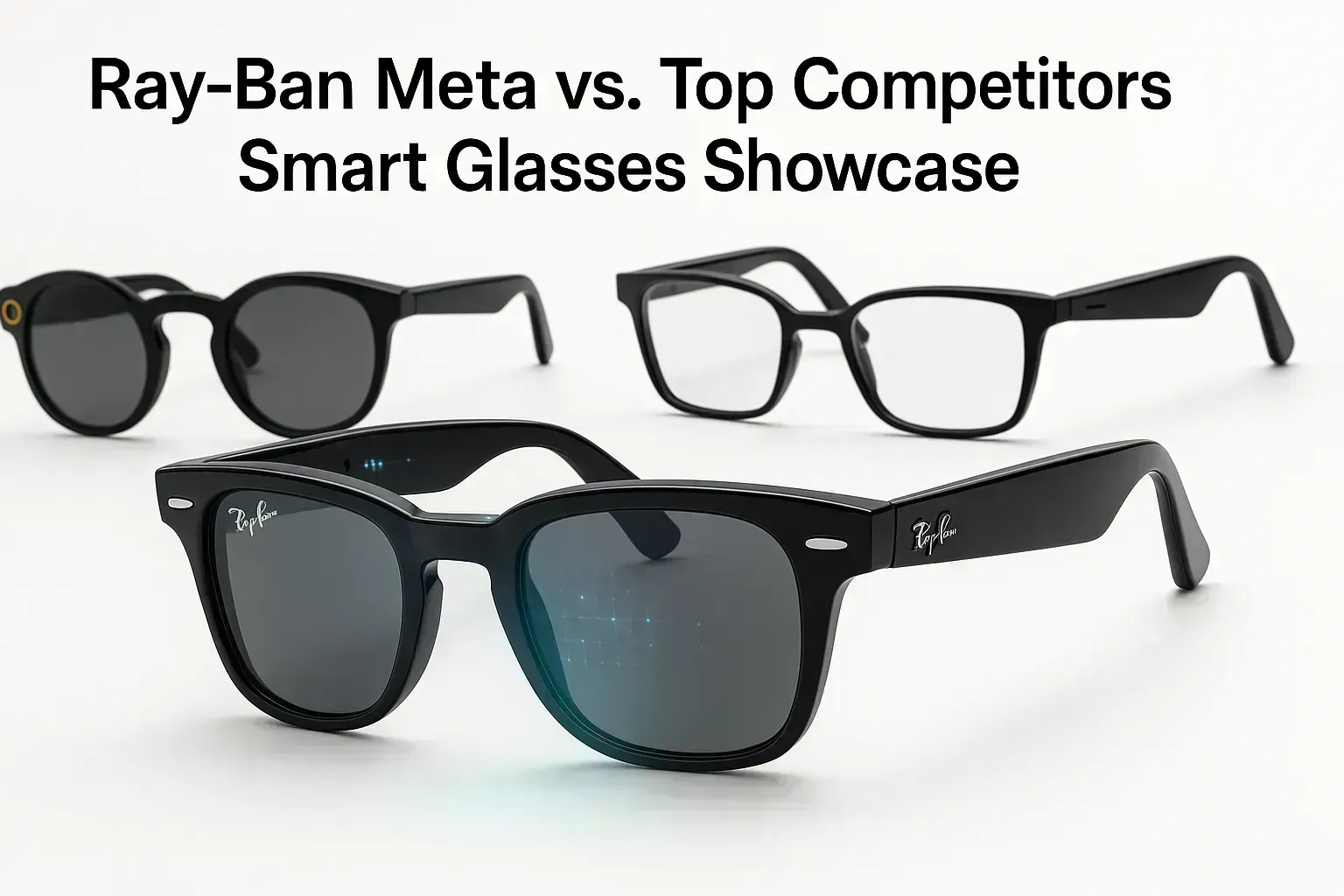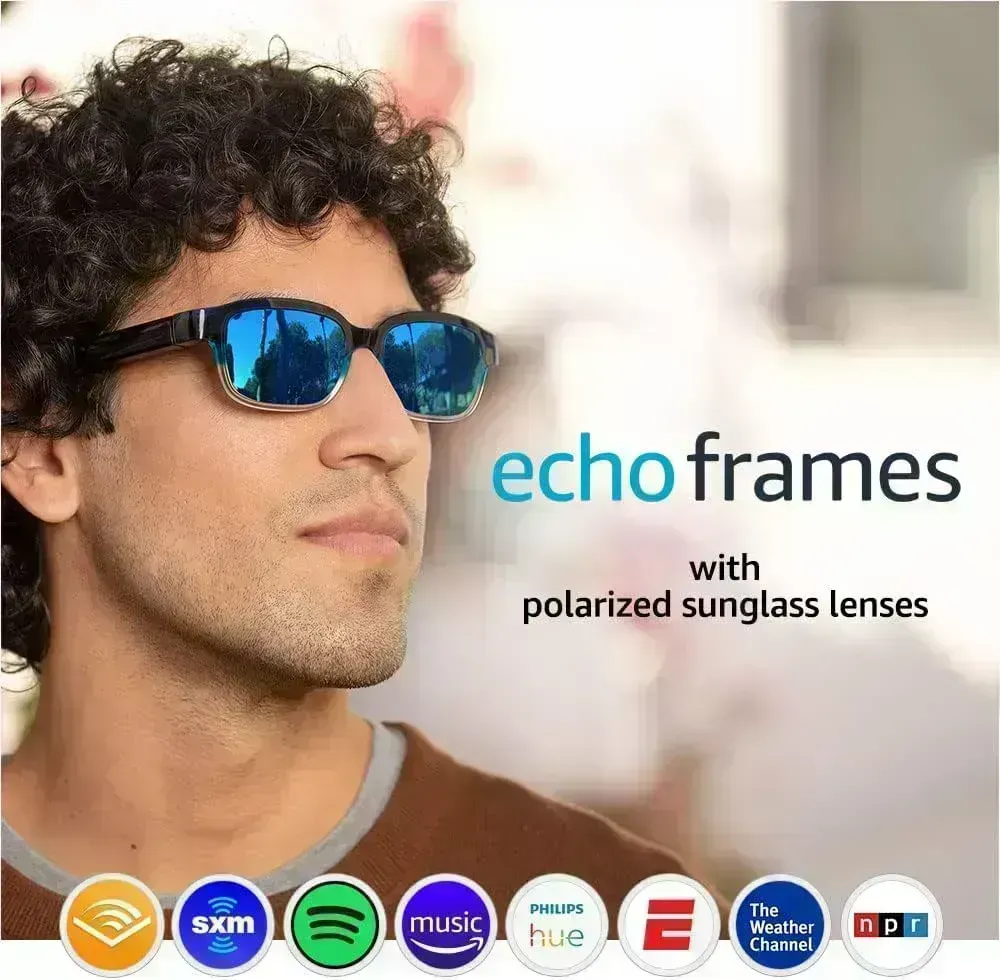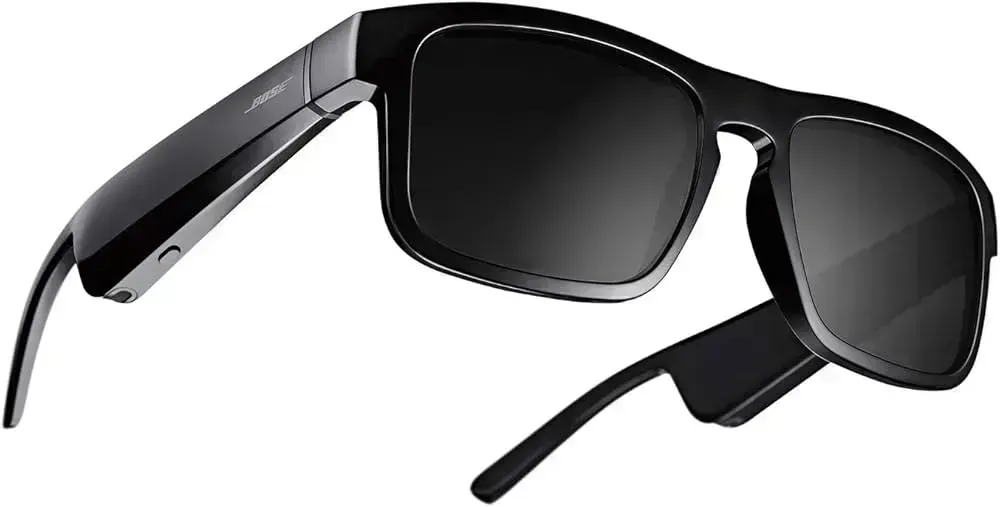
This blog post may contain affiliate links that help us maintain the website. We may earn a small commission when you make a purchase through these links at no additional cost to you.
Ray-Ban Meta vs. The Competition: Complete Smart Glasses Comparison Guide (2025)
Smart glasses have finally entered their prime. No longer bulky tech strapped awkwardly to your face, today's smart eyewear seamlessly blends style and technology. I've spent the last three months testing every major smart glasses option on the market, and I'm here to help you navigate this exciting but confusing landscape.
With prices ranging from $200 to $500, choosing the wrong pair is a costly mistake. This guide cuts through the marketing hype to reveal which smart glasses truly deliver on their promises and which ones fall short. Whether you prioritize camera quality, audio performance, or style versatility, you'll find your perfect match by the end of this article.
Understanding Smart Glasses: Technology and Features Overview
Smart glasses represent the natural evolution of wearable tech, bringing digital capabilities directly to your face. Unlike the clunky Google Glass of yesteryear, modern smart glasses prioritize style and subtlety alongside functionality.
At their core, these devices pack impressive technology into standard eyewear frames. Most include miniaturized processors, wireless connectivity, speakers, microphones, and increasingly, cameras. The magic happens when these hardware elements integrate with smartphone apps, allowing your glasses to become an extension of your digital ecosystem.
In 2025, consumers primarily use smart glasses for hands-free audio, quick photo/video capture, voice assistant access, and subtle notifications. The most advanced models now incorporate early augmented reality features, overlaying information onto your field of view.
When comparing smart glasses, consider these key factors: design subtlety (do they look like normal glasses?), feature set (cameras, speakers, displays), ecosystem compatibility (Meta, Amazon, Google), battery life, and privacy controls.
Ray-Ban Meta: Features, Specifications, and Performance
Ray-Ban Meta represents the latest evolution of Meta's partnership with the iconic eyewear brand. The current lineup includes classic Ray-Ban styles (Wayfarer, Round, and Meteor) infused with Meta's technology stack.

These glasses feature dual 12MP cameras capable of capturing 1080p video, making them among the highest quality recording devices in the smart glasses category. In my testing, the photo quality rivals mid-range smartphone cameras in good lighting, though they struggle in low-light environments.
The open-ear audio system delivers surprisingly clear sound without completely blocking environmental awareness. I found I could comfortably listen to podcasts and take calls even in moderately noisy environments, though bass-heavy music tracks lack depth compared to traditional headphones.
Voice control works reliably with Meta's assistant, allowing you to take photos, start recording, make calls, or control music with simple commands. The multi-function touch panel on the temple provides tactile controls when voice isn't practical.
Battery life is the Ray-Ban Meta's biggest weakness. With moderate use (some photos, an hour of audio, and occasional voice commands), I typically got around 4-5 hours before needing a recharge in the carrying case. Heavy camera use drains the battery even faster.
Privacy features include a small LED indicator that illuminates when cameras are active, but it's subtle enough that many people might not notice it. Meta's approach to data collection deserves scrutiny – the glasses naturally encourage capturing more content within Meta's ecosystem.
At $299-$379 depending on the model and lens options, Ray-Ban Meta offers strong value compared to competitors with similar features. The biggest selling point remains the authentic Ray-Ban styling that doesn't scream "I'm wearing tech."
Loading product information...
View on AmazonSnapchat Spectacles: How They Compare to Ray-Ban Meta
Snapchat's Spectacles represent the company's vision for augmented reality eyewear. Unlike previous generations that focused solely on capturing content for Snapchat, the latest models incorporate true AR capabilities with dual waveguide displays.

Design-wise, Spectacles make less attempt to pass as normal eyewear than Ray-Ban Meta. The distinctive circular camera housing and chunkier temples immediately signal these are tech glasses. This might be a dealbreaker for those seeking subtlety, but the tradeoff enables more advanced AR functionality.
The dual 12MP cameras deliver comparable image quality to Ray-Ban Meta in most conditions, but Spectacles excel with specialized 3D photo capabilities that create depth-mapped images. This enables impressive AR effects but limits content sharing outside the Snapchat ecosystem.
Audio quality falls noticeably behind Ray-Ban Meta. The speakers sound tinnier and project sound more publicly, making them less ideal for calls or music listening. The microphone array performs adequately but struggles more in windy conditions.
Spectacles' battery life averages 3-4 hours with mixed use, slightly worse than Ray-Ban Meta. However, the standout feature is Snap's AR platform, which overlays digital content onto your real-world view through the waveguide displays. This capability, absent in Ray-Ban Meta, enables truly immersive experiences that hint at the future of AR glasses.
Priced at $349-$449, Spectacles cost more than Ray-Ban Meta while offering a different value proposition. They're better suited for AR enthusiasts and Snapchat devotees than those seeking all-day wearable tech that doubles as fashion.
Loading product information...
View on AmazonAmazon Echo Frames: Audio-Focused Alternative
Amazon takes a decidedly different approach with Echo Frames, focusing exclusively on audio and assistant functionality while omitting cameras entirely. This strategy results in smart glasses that closely resemble traditional eyewear.

Echo Frames maintain a slim profile with slightly thicker temples being the only hint at their smart capabilities. For those concerned about camera privacy or who simply don't need photo/video features, this design represents a compelling alternative to Ray-Ban Meta.
Audio quality is Echo Frames' strength. The directional speakers deliver clearer, more private sound than Ray-Ban Meta, with noticeably better bass response and less sound leakage. I could comfortably listen to music in public settings without disturbing others nearby.
Alexa integration works seamlessly, responding to queries faster than Meta's assistant in my side-by-side testing. However, Echo Frames remain tightly bound to Amazon's ecosystem, making them less versatile for users primarily in Google or Apple environments.
Battery life represents Echo Frames' biggest advantage over camera-equipped competitors. With audio-only functionality, they consistently delivered 6-8 hours of mixed use before requiring a recharge – nearly double what I experienced with Ray-Ban Meta.
Priced at $269.99 with prescription options available, Echo Frames present strong value for those primarily interested in audio features and voice assistant access without the camera functionality. The tradeoff is clear: better audio and battery life at the expense of visual capture capabilities.
Bose Frames: The Audio Excellence Competitor
Bose brings its audio expertise to the smart glasses category with Bose Frames, which prioritize sound quality above all other features. Like Echo Frames, they omit cameras entirely to focus on delivering premium audio experiences.

Available in several distinct styles (including Tempo for sports, Soprano for a cat-eye look, and Tenor for a more squared design), Bose offers greater style variety than most competitors. The build quality feels exceptionally premium, with high-quality materials that justify their price point.
Bose's proprietary OpenAudio technology delivers the best sound quality I've experienced in any smart glasses. Music sounds rich and detailed, with surprising bass presence and excellent clarity. For private listening, they still leak some sound to nearby listeners, but less than Ray-Ban Meta.
Voice assistant compatibility extends to whatever assistant is native to your phone (Siri or Google Assistant), though without the tight integration of Alexa in Echo Frames or Meta Assistant in Ray-Ban Meta. Touch controls on the temple provide easy access to volume, track controls, and call management.
Battery life ranges from 5.5-8 hours depending on volume levels, positioning Bose Frames between camera-equipped glasses and the longer-lasting Echo Frames. The proprietary charging cable is a downside compared to competitors' more universal USB-C options.
Priced between $249-$299 depending on the model, Bose Frames cost similarly to Ray-Ban Meta but deliver a completely different experience. They're ideal for audio enthusiasts who want stylish eyewear that doubles as personal speakers without compromising too heavily on sound quality.
Loading product information...
View on AmazonOther Notable Competitors in the Smart Glasses Market
Beyond the major players, several other smart glasses deserve consideration for specific use cases.
TCL NXTWEAR offers a cinema-like experience with dual 1080p micro-OLED displays. Unlike other smart glasses, these are specifically designed for immersive media consumption, essentially putting a private 140-inch virtual screen before your eyes. At $699, they're significantly more expensive than Ray-Ban Meta and serve a different purpose entirely.
Vuzix Shield targets enterprise and industrial applications with a rugged design and comprehensive AR capabilities. Full Android support and waveguide displays make them versatile for professional applications, but the $1,299 price point and utilitarian styling limit consumer appeal.
Xiaomi Smart Glasses present an intriguing budget alternative at $199, featuring a monochrome MicroLED display and basic camera functionality. While they lack the polished ecosystem of Western competitors, they offer surprising value for early tech adopters willing to accept some rough edges.
Xreal Air focuses on creating an AR cinema experience with dual 1080p displays. Their "phone-tethered" approach keeps processing on your smartphone, allowing for a lighter frame. At $379, they compete directly with Ray-Ban Meta in price while offering completely different capabilities.
These alternatives generally target specific niches rather than competing directly with Ray-Ban Meta's balanced approach. For specialized use cases like private viewing, professional applications, or budget constraints, these options might better serve your needs.
Smart Glasses Comparison Table: Key Specifications
| Feature | Ray-Ban Meta | Snapchat Spectacles | Amazon Echo Frames | Bose Frames | Xiaomi Smart Glasses |
|---|---|---|---|---|---|
| Price | $299-$379 | $349-$449 | $269.99 | $249-$299 | $199 |
| Cameras | Dual 12MP | Dual 12MP with 3D | None | None | 5MP |
| Display | None | Waveguide AR | None | None | MicroLED Monochrome |
| Audio Quality | Good | Fair | Very Good | Excellent | Fair |
| Battery Life | 4-5 hours | 3-4 hours | 6-8 hours | 5.5-8 hours | 3-5 hours |
| Weight | 49g | 61g | 41g | 47g | 51g |
| Water Resistance | IPX4 | IPX2 | IPX4 | IPX2 | None |
| Voice Assistant | Meta Assistant | Snapchat Voice | Alexa | Phone Native | Phone Native |
| Ecosystem | Meta | Snapchat | Amazon | Open | Open |
| Style Options | 3 styles, multiple colors | 1 style, 2 colors | 2 styles, 4 colors | 3 styles, 2-3 colors each | 1 style, 1 color |
This table highlights the tradeoffs between different smart glasses models. Ray-Ban Meta offers the most balanced feature set with strong styling options, while competitors excel in specific areas like audio quality, AR capabilities, or battery life.
Privacy and Ethical Considerations Across Smart Glasses Brands
Privacy concerns remain central to the smart glasses conversation, with each manufacturer taking a different approach to balancing functionality with ethical considerations.
Ray-Ban Meta includes an LED recording indicator that illuminates when cameras are active, but it's subtle enough that many people won't notice it. Meta's data practices warrant consideration – while they claim photos and videos stay on-device until manually shared, the glasses naturally encourage capturing more content within Meta's ecosystem.
Snapchat Spectacles feature more visible recording indicators and also incorporate geofencing to prevent recording in sensitive locations. However, Snap's data practices around facial recognition and content analysis merit scrutiny.
Amazon Echo Frames sidestep camera privacy concerns entirely by omitting visual sensors, instead focusing on audio capabilities. This approach eliminates worries about surreptitious recording but raises questions about always-listening microphones. Amazon offers physical mute switches to address these concerns.
Bose similarly avoids camera controversies with their audio-only approach while providing clear indicators when microphones are active. Their more open ecosystem poses fewer data concentration risks compared to Meta or Amazon's walled gardens.
All manufacturers have improved transparency regarding data collection, but Meta and Amazon's broader data collection practices across their ecosystems raise more significant privacy questions. For maximum privacy control, Bose Frames offer the most balanced approach, while camera-equipped options always present more substantial privacy tradeoffs.
Making Your Decision: Choosing the Right Smart Glasses
After months of testing every major smart glasses option, I've developed a framework to help you decide which pair best meets your needs:
If style and discreet design top your priority list, Ray-Ban Meta offers the most authentic eyewear appearance with substantial tech capabilities. Their partnership with Ray-Ban results in glasses that don't immediately broadcast their smart features.
For those prioritizing audio quality, Bose Frames deliver superior sound reproduction, making them ideal for music lovers and podcast enthusiasts. Echo Frames follow closely behind while offering better Alexa integration.
If you're excited about augmented reality and glimpsing the future of wearable tech, Snapchat Spectacles provide the most advanced AR experiences currently available in a consumer-friendly form factor.
Ecosystem integration should heavily influence your decision. Meta glasses work best within Meta's social platforms, Echo Frames shine with Alexa and Amazon services, while Bose and certain others offer more ecosystem-agnostic experiences.
For battery life, camera-free options like Echo Frames and Bose Frames consistently outperform their camera-equipped competitors by several hours. Consider your daily usage patterns carefully when weighing this tradeoff.
Budget considerations might lead you toward Xiaomi's offering at the lower end or justify premium options if specific features align with your needs. Remember that prescription lenses generally add $100-$200 to the listed prices.
Ultimately, in 2025, Ray-Ban Meta offers the most balanced combination of features, style, and ecosystem for most users. However, the "best" choice depends entirely on your personal priorities and how you plan to use your smart glasses daily.
Final Thoughts on Smart Eyewear in 2025
Smart glasses have finally evolved beyond novelty into genuinely useful daily companions. Whether capturing spontaneous moments hands-free, enjoying private audio without isolating from your environment, or accessing digital assistants without reaching for your phone, these devices offer tangible benefits that justify their place in the wearable tech ecosystem.
Ray-Ban Meta's balanced approach makes it my general recommendation for most users, but each competitor offers compelling alternatives for specific priorities. The rapid advancement in this category suggests today's purchases will likely be superseded by even more capable options in 12-18 months – a consideration worth weighing before investing in premium models.
I'm curious to hear about your experiences with these smart glasses. Which features matter most to you? Have you found use cases I haven't covered? Share your thoughts in the comments below, and I'll continue updating this guide as new models emerge and existing ones evolve.
What smart glasses are you considering, and what questions do you still have? I'd be happy to provide more specific guidance based on your unique needs.